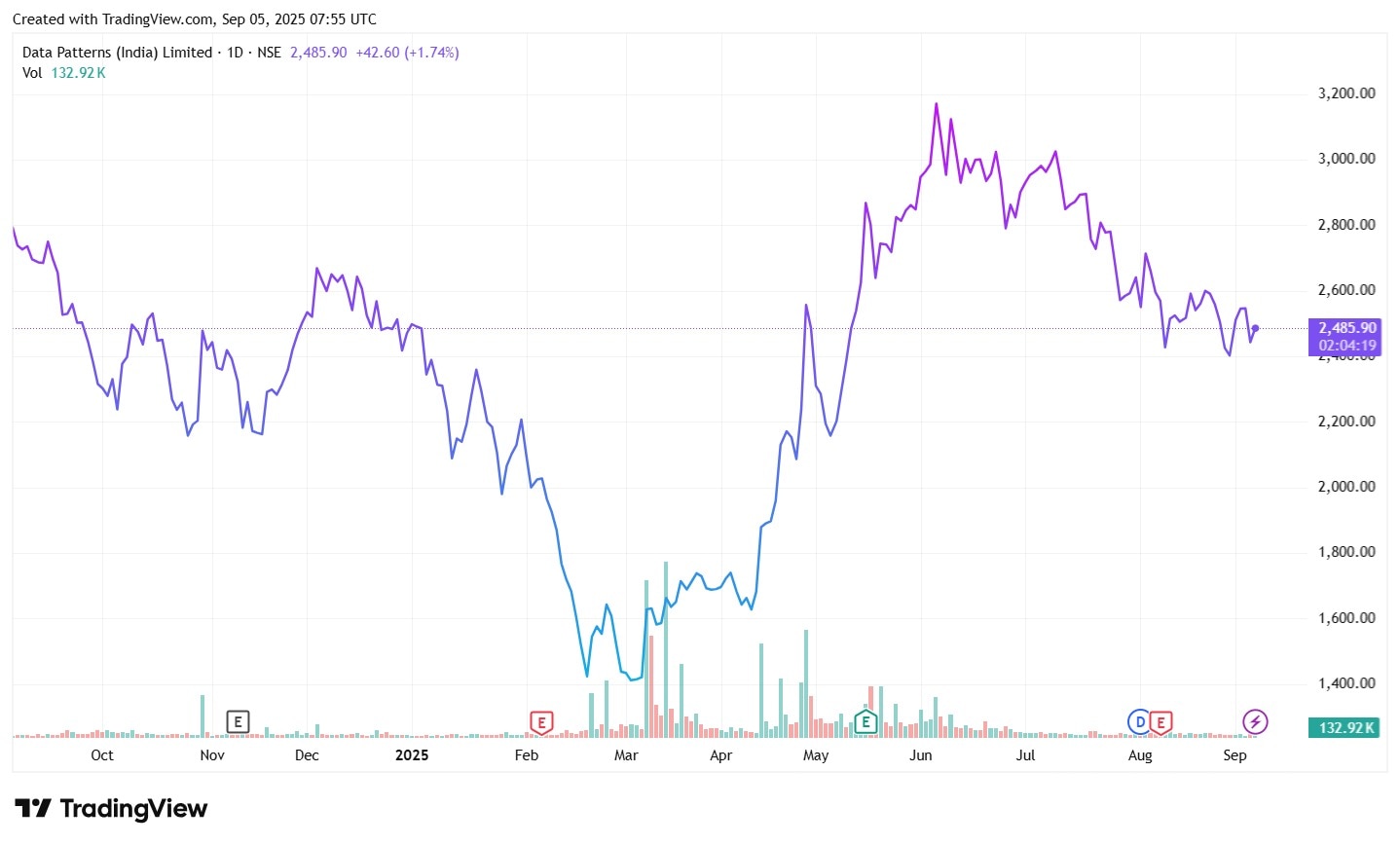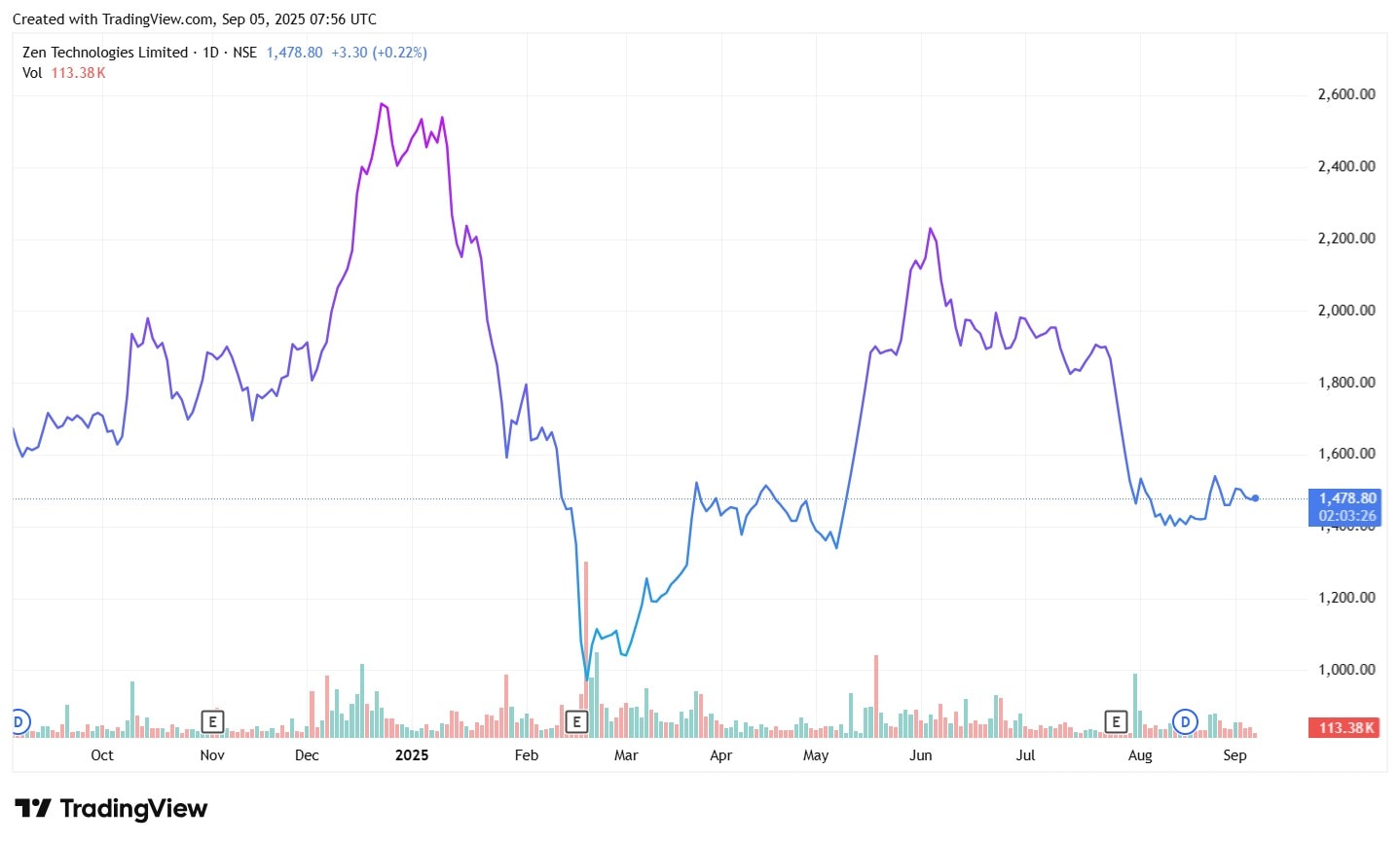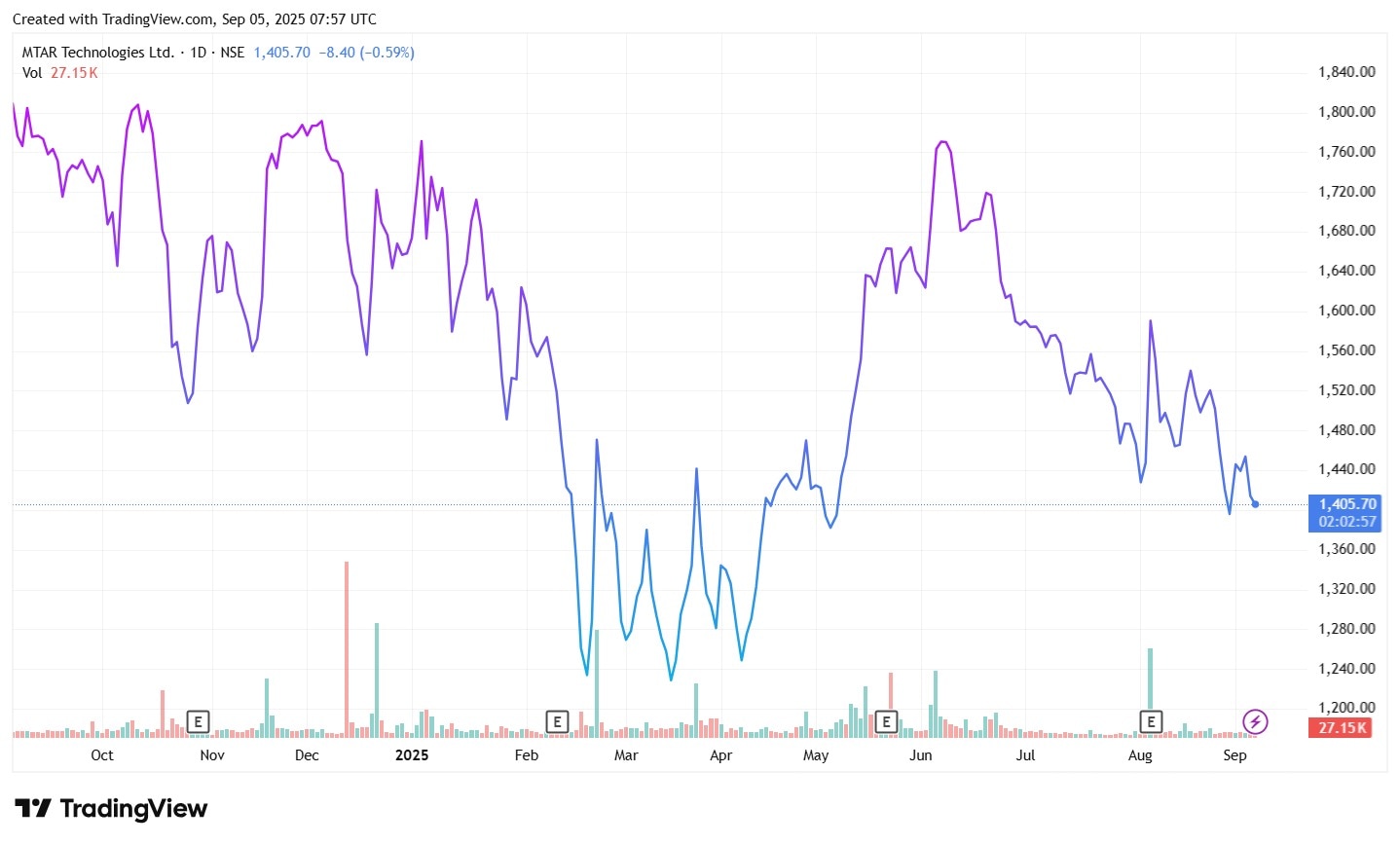India has always prioritized its defence sector, all thanks to our neighbors. The defence budget over the past decade has surged 2.6x to ₹6.81 lakh crore in FY 2025-26. This increased defence spending has helped the country also grow its exports of defence goods rapidly. During FY25, defence exports increased to a record high of ₹23,622 crore, which stood at only ₹686 crore in FY14. (Source: PIB)
The overall defence production has also surged to new highs in these years. During FY20, the defence production stood at ₹79,071 crore, which has surged to ₹1,50,590 crore in FY25, a growth of over 90%. (Source: PIB)
Out of the total production, Defence Public Sector Undertakings (DPSUs) contributed to around 77% while the private sector contribution has been around 23%, which has grown from 21% in FY24.
The government’s push for defence manufacturing has been playing an integral role here in developing this sector. The defence stocks have been benefiting from this astounding growth in the sector. So, here we will try to evaluate three defence stocks that have grown robustly in the last decade, as per sales growth.
#1 Data Patterns (India) Limited (DATAPATTNS)
Data Patterns (India) Ltd. is one of the fastest-growing companies in the defence arena, owing to its indigenously developed electronic products for defence uses. It primarily develops and manufactures radars which are used in advanced light helicopters, fire control mechanisms, Su-30, and also in the famous MIG-29. Data Patterns is also known for its electronic warfare products, which include Airborne software-defined radios, radar warning receivers, jammer pods, and others. It also offers communication systems such as Manpack Radio, Airborne Programmable radio hardware, and more.
In the past ten years, the company’s sales grew at a 30.37% Compound Annual Growth Rate (CAGR). From mere ₹42 crore in FY16 to ₹708 crore in FY25, the company has come a long way.
Along with the growing sales, the net profit of the firm also surged over the past ten years. The net profit went from ₹1 crore in FY16 to ₹222 crore in FY25, growing at a staggering 56% CAGR. Given the rise in profits, the earnings per share also went up from ₹4.71 to ₹39.62 during this period.
So, what fueled this massive growth?
Growth in diversity
One reason driving growth for this defence electronics player is its excellent portfolio of products. The company has designed building blocks of the Radar system in India, along with building blocks for signal processing, transmit or receive modules, and others. It has designed a wide open RWR and ELINT for airborne platforms, which is one of its major developments. It also delivered components for the SONARS Servo and Actuator Control System and many others.
Another reason could be its strong, diversified order book…
Data Patterns has been growing owing to its diversity as well. While the Radar system brings most of the revenue to the firm, its current order book shows an increase in orders for Avionics and AMC services as well.
Some of the top customers of Data Patterns include –
- Bharat Electronics Limited (BEL)
- Hindustan Aeronautics Limited (HAL)
- Defence Research and Development Organization (DRDO)
Another interesting aspect of this company is that it maintains a net debt-free status, which is growing at such a pace.
Growth prospect
The company management expects orders worth ₹3,000 crore in the upcoming 2 years. They also expect its revenue to grow at 20% to 25% CAGR for the next 2-3 years.
Interesting valuation
Coming to the company’s valuation…
It is trading at a price earnings (PE) ratio of 63.9x, which is slightly lower than the industry median of 67.9x; however, its Price earnings to growth (PEG) ratio is at 2, which is higher than the industry median of 1.4.
1-Year Share Price Chart

#2 Zen Technologies Limited (ZENTEC)
Zen Technologies Ltd. is one of the leading suppliers of simulation training equipment and anti-drone systems in the country. It specializes in manufacturing combat training solutions and counter-drone solutions for the defence and security sector.
The company has grown its sales at a 28.6% CAGR in the past ten years. The sales of the firm went up from ₹53 crore in FY16 to ₹974 crore in FY25.
Along with the growing sales, the profit of the firm also skyrocketed. It went up from ₹2 crore in FY16 to ₹299 crore in FY25, growing at a 33% CAGR. The EPS went up from ₹0.3 per share to ₹31 per share during the period.
So, what has been driving the growth for this defence player?
Wide product portfolio
- It offers live and indoor firing ranges, which come with target systems, short houses, and other facilities
- Live simulation systems, which include ACTS, TacSim, for realistic and confidential training for armed forces
- It also offers virtual simulation like ATGM, Mortar simulators, UAV mission Sim, and more
- Combat Training Centre (CTC)
- Operational equipment – ShootEdge, which is an advanced pistol adapter, Anti-drone System (CUAS)
A loyal clientele
The Ministry of Defence (MoD) has been one of the prime clients of Zen Technologies. Apart from the MoD, it receives repetitive orders from the police and paramilitary forces in the country, and various other government departments. Interestingly enough, 90% of the sales generated by the company come from repeat customers who are loyal to the firm. This is perhaps one of the reasons that has helped the company witness such growth in its sales over these years.
Steady investment in R&D
Zen Technologies has been spending a significant portion of its revenue on R&D. As of 9MFY25, the company has 172+ applications for patents. The R&D department of the firm is recognized and supported by the Ministry of Science and Technology and the Department of Scientific and Industrial Research (DSIR). The continuous effort to come up with new solutions might also have been working for the company to drive its growth.
Way ahead
The company expects an order inflow of ₹800 crore in H1FY26, out of which ₹150 crore has already been received in the first three months of this fiscal. The current order book stands at ₹754.6 crore as of 30 June 2025, which also includes orders of subsidiaries.
It is also scaling its AMC business so that the revenue contribution from the segment can take care of their fixed operating expenses.
Cheap valuation?
Even after growing at such a pace, the company is trading relatively cheap, at a PE of 53x, compared to the industry median of 68x. Even from the growth’s perspective, the PEG ratio tells the same story. The company’s PEG ratio stands at 0.13 while the industry median is 1.4.
1-Year Share Price Chart

#3 MTAR Technologies Limited (MTARTECH)
MTAR Technologies Ltd. is engaged in the manufacturing of equipment and components for aerospace, defence, nuclear, and clean energy sectors. What sets MTAR apart is its critical and differentiated engineered products range, which is crucial for many high-tech industries.
During the last ten years, the company’s sales have sharply grown from ₹81 crore in FY16 to ₹676 crore in FY25, which is at a 24% CAGR. The net profit, which was negligible in FY16, rose to ₹54 crore in FY25, growing at a 30% CAGR. The company offered an EPS of ₹17.5 per share in FY25, while 10 years back, it was just ₹0.06 per share.
High-end products
This robust growth is a result of different factors coming together, and one of them is its ever-expanding product portfolio. The company manufactures some of the complex components for which the competition in the market is negligible.
- For the aerospace and defence sector, it manufactures precision-engineered assemblies, gearboxes, actuation systems, aerostructures, and more.
- For the space sector, it develops liquid propulsion engines, electro-pneumatic modules, grid fin structures, cryogenic engine sub-systems, and more.
- For the clean energy space, it offers power units, or to be more precise, hot boxes, and also offers prototype hydrogen boxes and electrolyzers.
- Apart from these, it offers high-end fabrication, high-precision sheet metal, and other engineering products.
Way ahead
During Q1FY26, the company started producing new products for GKN Aerospace, Rafael, IAI, Elbit, and Thales, which are expected to drive its sales further in FY26. The order book stood at ₹930.2 crore as of 30 June 2025.
The management expects orders worth ₹1,000 crore for the civil nuclear segment in the coming 3 to 6 months, and the execution of the sale will be over next 3 years.
Valuation
The company is trading at a PE of 71.5x, which is slightly expensive when compared to the industry median of 68.3x.
1-Year Share Price Chart

Wrapping up
So, the robust growth seen in these defence stocks is mostly owing to their wide product portfolio and a growing order book. However, valuations of these companies look stretched in most cases. With the geopolitical developments earlier this year, the defence sector remains one of the top priorities of the government. So, it will be interesting to keep track of these defence stocks and see how they grow in the coming days.
We have relied on data from www.Screener.in throughout this article. Only in cases where the data was not available have we used an alternate, but widely used and accepted source of information.
Disclaimer:
The purpose of this article is only to share interesting charts, data points and thought-provoking opinions. It is NOT a recommendation. If you wish to consider an investment, you are strongly advised to consult your advisor. This article is strictly for educative purposes only.
Maumita Mitra is a seasoned writer specializing in demystifying the world of investment for a broad audience. She has a keen eye for detail and a knack for explaining complex financial concepts in the simplest manner possible.
Disclosure: The writer and her dependents do not hold the stocks discussed in this article.
The website managers, its employee(s), and contributors/writers/authors of articles have or may have an outstanding buy or sell position or holding in the securities, options on securities or other related investments of issuers and/or companies discussed therein. The content of the articles and the interpretation of data are solely the personal views of the contributors/ writers/authors. Investors must make their own investment decisions based on their specific objectives, resources and only after consulting such independent advisors as may be necessary.

